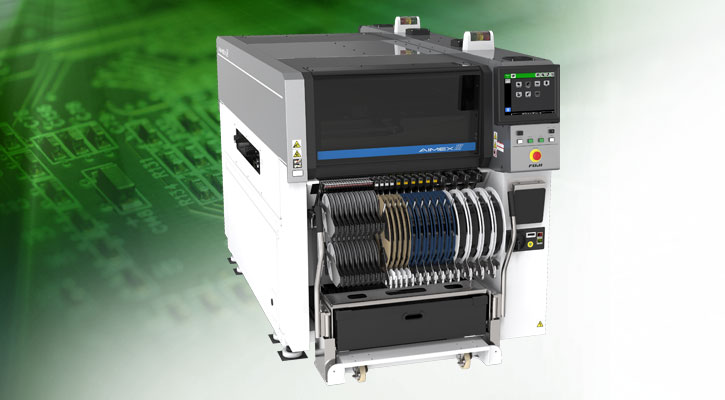 Welcome to the Hack Chat everyone, Dan here with Dusan to moderate for Chris Denney as we kick off our Pick and Place Hack Chat.
Welcome to the Hack Chat everyone, Dan here with Dusan to moderate for Chris Denney as we kick off our Pick and Place Hack Chat.
 Yeah, I'm a dope
Yeah, I'm a dope
 Couldn't help the "hello everybody" when seeing Nicolas' profile
Couldn't help the "hello everybody" when seeing Nicolas' profile
 Welcome aboard Chris. Can you tell us a little about yourself, and maybe a bit about the podcast?
Welcome aboard Chris. Can you tell us a little about yourself, and maybe a bit about the podcast?
 Hey everyone! Yeah, I thought the email title was weird...
Hey everyone! Yeah, I thought the email title was weird...
 Yeah sure
Yeah sure
 Thanks Chris, you're the first
Thanks Chris, you're the first
 I've been working in something related to the manufacturing of circuit boards since I was 16 years old. I've had lots of jobs in between what I'm doing now, which is I'm the CTO for an electronics contract manufacturer in South Deerfield, MA called Worthington Assembly.
I've been working in something related to the manufacturing of circuit boards since I was 16 years old. I've had lots of jobs in between what I'm doing now, which is I'm the CTO for an electronics contract manufacturer in South Deerfield, MA called Worthington Assembly.
 The Pick, Place, Podcast grew out of lock down to be honest.
The Pick, Place, Podcast grew out of lock down to be honest.
 We used to do tours all the time for people so that they could get a better understanding of how to design their products to make them easier to assemble.
We used to do tours all the time for people so that they could get a better understanding of how to design their products to make them easier to assemble.
 A lot of things did, or so it seems
A lot of things did, or so it seems
 But then during the beginning of covid we couldn't do tours anymore. So to keep the ball rolling with helping junior and mid-level engineers, we started the podcast as a way of describing how things are made and best practices to make getting *your* things made more easily.
But then during the beginning of covid we couldn't do tours anymore. So to keep the ball rolling with helping junior and mid-level engineers, we started the podcast as a way of describing how things are made and best practices to make getting *your* things made more easily.
 @Nicolas Tremblay oh, I know I am. Surely, nobody has *ever* said that to you before. Just like nobody ever asks me if they can get a Grand Slam Breakfast.
@Nicolas Tremblay oh, I know I am. Surely, nobody has *ever* said that to you before. Just like nobody ever asks me if they can get a Grand Slam Breakfast.
 The podcast is still just a side project. I still spend 40 hours a week actually running an electronics manufacturing operation. But definitely, it's my favorite thing I'm working on right now.
The podcast is still just a side project. I still spend 40 hours a week actually running an electronics manufacturing operation. But definitely, it's my favorite thing I'm working on right now.
 Despite the fact that I just completed a dream project of mine. I got to evaluate and spec out a brand new pick and place line. We just sent in an order last week for nearly $1M worth of gear. That was a really fun project actually.
Despite the fact that I just completed a dream project of mine. I got to evaluate and spec out a brand new pick and place line. We just sent in an order last week for nearly $1M worth of gear. That was a really fun project actually.

https://www.fujiamerica.com/AIMEXIII.html
AIMEX III
Fuji America AIMEXII Flexible Placement Platforms are designed for component flexibility, PCB flexibility and production flexibility. The AIMEXII features an optimum conveyance line, support for new production introduction, V-advance and tray unit versatility.
 That's the platform we went with. It's designed and manufactured in Japan. Fuji is probably the largest manufacturer of pick and place gear in the world. It's amazing gear.
That's the platform we went with. It's designed and manufactured in Japan. Fuji is probably the largest manufacturer of pick and place gear in the world. It's amazing gear.
 I sort of feel like a man going through a midlife crisis who just bought a Ferrari lol
I sort of feel like a man going through a midlife crisis who just bought a Ferrari lol
 Using somebody else's checkbook to boot. I miss the days of spending company money ;-)
Using somebody else's checkbook to boot. I miss the days of spending company money ;-)
 Are there that many needs for these pcbs? Junior engineers and designers don't buy much. Or do they? What drives this?
Are there that many needs for these pcbs? Junior engineers and designers don't buy much. Or do they? What drives this?
 lol - yeah, kind of. I have a certain level of interest in the company, so I prefer not to spend too much of it
lol - yeah, kind of. I have a certain level of interest in the company, so I prefer not to spend too much of it
 @RichardCollins honestly, it's just a passion to teach. When you first explain to a person what a fiducial is and why it's important, they light up. It's a great feeling.
@RichardCollins honestly, it's just a passion to teach. When you first explain to a person what a fiducial is and why it's important, they light up. It's a great feeling.
 Those junior engineers become senior engineers who eventually order PCB's. Or they tell their senior engineer what they learned on the PPP and they decide to listen too.
Those junior engineers become senior engineers who eventually order PCB's. Or they tell their senior engineer what they learned on the PPP and they decide to listen too.
 And a question somewhat related to @RichardCollins:
And a question somewhat related to @RichardCollins:
A general question about the assembly business. It seems very distributed -- lots of small to medium sized contract manufacturers spread out all over the place. Is that perception correct? If so, what does that say about the assembly market?
 @Dan Maloney 100% correct
@Dan Maloney 100% correct
 @Chris Denney How do you go about picking between different machines at that scale - Fuji, Yamaha etc? All offer amazing machines and feature sets etc.
@Chris Denney How do you go about picking between different machines at that scale - Fuji, Yamaha etc? All offer amazing machines and feature sets etc.
 Most of the assembly houses are surviving on 2 or 3 key customers.
Most of the assembly houses are surviving on 2 or 3 key customers.
 Those customers tend to grow very little and shrink very little, so their suppliers tend to grow very little or shrink very little.
Those customers tend to grow very little and shrink very little, so their suppliers tend to grow very little or shrink very little.
 A CM might have 50 different customers, but those 2 or 3 customers make up 80% of their business.
A CM might have 50 different customers, but those 2 or 3 customers make up 80% of their business.
 (side point: worthington is VERY different from this business model, but I digress)
(side point: worthington is VERY different from this business model, but I digress)
 @Dan Maloney That is my perception too - global fragmentation. Constant scrambling with no real direction or purpose.
@Dan Maloney That is my perception too - global fragmentation. Constant scrambling with no real direction or purpose.
 Funny, I would have thought all assembly would have been off-shored years ago. It appears not though
Funny, I would have thought all assembly would have been off-shored years ago. It appears not though
 @Unexpected Maker dude, it's freaking hard. Honestly. It took me over 3 years to research them all and narrow them down to just 2 manufacturers. They all make great stuff. You really need to look at yourself and what your goals are and try to find a supplier that really closely aligns to that.
@Unexpected Maker dude, it's freaking hard. Honestly. It took me over 3 years to research them all and narrow them down to just 2 manufacturers. They all make great stuff. You really need to look at yourself and what your goals are and try to find a supplier that really closely aligns to that.
 @Dan Maloney The delays and uncertainty are too costly. Better to do it yourself.
@Dan Maloney The delays and uncertainty are too costly. Better to do it yourself.
 Yes, for any kind of volume, it largely has. But anything 10,000 pieces an under, it still tends to get done domestically. That's not absolutely true, but that's what we're seeing.
Yes, for any kind of volume, it largely has. But anything 10,000 pieces an under, it still tends to get done domestically. That's not absolutely true, but that's what we're seeing.
 @Dan Maloney and communication breakdowns happen often, with delayed turnarounds for resolutions.
@Dan Maloney and communication breakdowns happen often, with delayed turnarounds for resolutions.
 IP concerns are a big part of it too. American companies tend to trust American suppliers more to protect their IP.
IP concerns are a big part of it too. American companies tend to trust American suppliers more to protect their IP.
 @Unexpected Maker So true. We source PCB's from a Chinese supplier. They do amazing work. And after 6+ years of working directly with them, we have a great system for communicating with them. But even still, the time delay can be brutal.
@Unexpected Maker So true. We source PCB's from a Chinese supplier. They do amazing work. And after 6+ years of working directly with them, we have a great system for communicating with them. But even still, the time delay can be brutal.
 @Chris Denney I have been calling that "under 10,000" something like "short run manufacturing" as a part of the early development and proof of concept. Then it gets taken and makes money for someone else.
@Chris Denney I have been calling that "under 10,000" something like "short run manufacturing" as a part of the early development and proof of concept. Then it gets taken and makes money for someone else.
 @RichardCollins yep, makes sense.
@RichardCollins yep, makes sense.
 We're fine with that too. We're never heartbroken over a customer outgrowing us.
We're fine with that too. We're never heartbroken over a customer outgrowing us.
 Some CM's will actually partner with an overseas assembly shop to take customers from the sub-10,000 pieces to 10,000+ pieces. I honestly don't know how effective it is, but I've heard of it.
Some CM's will actually partner with an overseas assembly shop to take customers from the sub-10,000 pieces to 10,000+ pieces. I honestly don't know how effective it is, but I've heard of it.
 What range of things can you make?
What range of things can you make?
 oh god, that podcast idea sounds amazing, how did I not know of this
oh god, that podcast idea sounds amazing, how did I not know of this
 @RichardCollins We really try to just focus on circuit board assembly. For large enough customers we'll branch out into box builds and functional test, and that sort of thing. But really we just want to optimize for circuit board assembly.
@RichardCollins We really try to just focus on circuit board assembly. For large enough customers we'll branch out into box builds and functional test, and that sort of thing. But really we just want to optimize for circuit board assembly.
 @Arsenijs lol - yeah, I'm terrible at marketing it honestly lol
@Arsenijs lol - yeah, I'm terrible at marketing it honestly lol
 let's see! ^^
let's see! ^^
 Here's the RSS feed https://feeds.buzzsprout.com/1066066.rss
Here's the RSS feed https://feeds.buzzsprout.com/1066066.rss
 I will say, the cool thing about the podcast is that you can totally tell when somebody is a listener.
I will say, the cool thing about the podcast is that you can totally tell when somebody is a listener.
 By which I mean, when we go to assemble a board of somebody who's a listener, you can see all of the tell-tale signs of them listening carefully and following our advice. It's super cool.
By which I mean, when we go to assemble a board of somebody who's a listener, you can see all of the tell-tale signs of them listening carefully and following our advice. It's super cool.
 Those jobs just sling through the factory.
Those jobs just sling through the factory.
 I only found out about the podcast today because of this hack chat. Bummed I didn't know about ti sooner!
I only found out about the podcast today because of this hack chat. Bummed I didn't know about ti sooner!
 same, and same!
same, and same!
 Then you get the orders where somebody clearly hasn't baked their design enough and it's like cold molasses in a Massachusetts winter.
Then you get the orders where somebody clearly hasn't baked their design enough and it's like cold molasses in a Massachusetts winter.
 @Chris Denney So what's the smallest job size you'll take on with a customer?
@Chris Denney So what's the smallest job size you'll take on with a customer?
 We take 1 piece orders. Most domestic shops do. But usually those 1 pieces orders are insanely complex boards. For the most part, the minimum cost of setting up an SMT line for an assembly is significant enough that most people order at least like 5 boards or more.
We take 1 piece orders. Most domestic shops do. But usually those 1 pieces orders are insanely complex boards. For the most part, the minimum cost of setting up an SMT line for an assembly is significant enough that most people order at least like 5 boards or more.
 We love the complicated 1 piece orders though. In some ways they're so much easier than a 500 piece order.
We love the complicated 1 piece orders though. In some ways they're so much easier than a 500 piece order.
 Your "board with listener" comment sounds like you are proposing useful directions and products too. Do you have some favorite things you like to work on?
Your "board with listener" comment sounds like you are proposing useful directions and products too. Do you have some favorite things you like to work on?
 You can muscle through almost any complicated problem on a 1 piece order. But if you get even one significant problem on a 500 piece order.... nightmare.
You can muscle through almost any complicated problem on a 1 piece order. But if you get even one significant problem on a 500 piece order.... nightmare.
 Ha! Tuning for 1 board is def easier than getting consistency on 500 or 5000. Well, with a $1 million line, that should not be a problem!
Ha! Tuning for 1 board is def easier than getting consistency on 500 or 5000. Well, with a $1 million line, that should not be a problem!
 @RichardCollins Yeah absolutely. On the podcast we give all kinds of best practices. We don't necessarily recommend products, but we recommend just basic good sense things like clear polarity indicators, legible silkscreen, green solder mask, use of fiducials, etc.
@RichardCollins Yeah absolutely. On the podcast we give all kinds of best practices. We don't necessarily recommend products, but we recommend just basic good sense things like clear polarity indicators, legible silkscreen, green solder mask, use of fiducials, etc.
 @Unexpected Maker hahaha, yeah well... that $1M line gets you a lot of horsepower and tools to solve problems. But it can't fix a bad design.
@Unexpected Maker hahaha, yeah well... that $1M line gets you a lot of horsepower and tools to solve problems. But it can't fix a bad design.
 So do you offer in line testing? Do you provide services to built those tests? how do you validate your assembly is correct?
So do you offer in line testing? Do you provide services to built those tests? how do you validate your assembly is correct?
 Usually if a board is well designed, we have no trouble assembling it. It's when the board has some kind of weird design issue that we end up struggling. I call it a "weird design issue" and not necessarily a "design flaw". Because sometimes it's a perfectly fine design, but it's a design to that makes manufacturing difficult.
Usually if a board is well designed, we have no trouble assembling it. It's when the board has some kind of weird design issue that we end up struggling. I call it a "weird design issue" and not necessarily a "design flaw". Because sometimes it's a perfectly fine design, but it's a design to that makes manufacturing difficult.
 Why green solder mask specifically? Do other colors cause optical problems or something?
Why green solder mask specifically? Do other colors cause optical problems or something?
 I get asked to do small CM work all the time, and I knock it all back - I just don't want to be responsible for a product I didn't design .
I get asked to do small CM work all the time, and I knock it all back - I just don't want to be responsible for a product I didn't design .
 @Unexpected Maker Under 10,000 pieces (honestly probably under 100,000 pieces) nobody does actual "inline" testing. It'll be done at a workbench in batches. Yes, we do offer that. And as a matter of fact, that's the next episode of the podcast! Totally not kidding. We're having the folks from FixturFab on the show. We're recording tomorrow and will be publishing it on the 21st.
@Unexpected Maker Under 10,000 pieces (honestly probably under 100,000 pieces) nobody does actual "inline" testing. It'll be done at a workbench in batches. Yes, we do offer that. And as a matter of fact, that's the next episode of the podcast! Totally not kidding. We're having the folks from FixturFab on the show. We're recording tomorrow and will be publishing it on the 21st.
 @Dan Maloney Yes, 100>#/span###
@Dan Maloney Yes, 100>#/span###
 Green has been used for so long that the chemical companies have just nailed it
Green has been used for so long that the chemical companies have just nailed it
 @Dan Maloney green is definitely easier to reflow, and generally you get better solder-mask tolerances and accuracy from PCB manufacturers with green. They've just been doing it for longer and have better processes I think.
@Dan Maloney green is definitely easier to reflow, and generally you get better solder-mask tolerances and accuracy from PCB manufacturers with green. They've just been doing it for longer and have better processes I think.
 So your podcast, reaching out to young designers is an investment in growth of a market. The markets I know use sensors and control systems that might use these pcbs, but need to interface to MegaWatt and larger systems. Things that new designers work on probably need a global community to have enough brains to click and grow.
So your podcast, reaching out to young designers is an investment in growth of a market. The markets I know use sensors and control systems that might use these pcbs, but need to interface to MegaWatt and larger systems. Things that new designers work on probably need a global community to have enough brains to click and grow.
 You can get the finest lines and the best finishes. So when you have your fancy 0.4mm pitch QFN on the board, the PCB fab will have no trouble getting solder mask dams between the pads so that the assembly shop doesn't deal with all kinds of nasty solder bridges.
You can get the finest lines and the best finishes. So when you have your fancy 0.4mm pitch QFN on the board, the PCB fab will have no trouble getting solder mask dams between the pads so that the assembly shop doesn't deal with all kinds of nasty solder bridges.
 Also, AOI (automated optical inspection) systems really like green. Colors like red and white can be done, they just take more fine tuning.
Also, AOI (automated optical inspection) systems really like green. Colors like red and white can be done, they just take more fine tuning.
 Black is annoying because it's just hard to see black parts on a black board. Think about it. A missing 0402 resistor stands out on a green board. It's practically invisible on a black board.
Black is annoying because it's just hard to see black parts on a black board. Think about it. A missing 0402 resistor stands out on a green board. It's practically invisible on a black board.
 @Chris Denney Most "good" PCB houses are getting much better at black solder-mask. It used to be an issue, but even with 0.4mm pitch, they can do solder-mask bridges properly now. If only they could get consistent batch colours.... that would be nice! So many shades of black ;)
@Chris Denney Most "good" PCB houses are getting much better at black solder-mask. It used to be an issue, but even with 0.4mm pitch, they can do solder-mask bridges properly now. If only they could get consistent batch colours.... that would be nice! So many shades of black ;)
 @Unexpected Maker yep. They're getting much better. We usually have to push a new PCB supplier to do it with black because they think they can't. But eventually they figure it out.
@Unexpected Maker yep. They're getting much better. We usually have to push a new PCB supplier to do it with black because they think they can't. But eventually they figure it out.
 Most of the PCB suppliers we've been using for years have gotten good at it and don't have any trouble with it now.
Most of the PCB suppliers we've been using for years have gotten good at it and don't have any trouble with it now.
 The other annoying thing about black PCB's is that they reflect so little light that PCB sensors in automated machines can sometimes struggle with seeing the PCB.
The other annoying thing about black PCB's is that they reflect so little light that PCB sensors in automated machines can sometimes struggle with seeing the PCB.
 So for example when the PCB has reached the end of a conveyor, that sensor that's looking for the PCB to arrive might not get enough reflected light off the PCB to know that it has arrived.
So for example when the PCB has reached the end of a conveyor, that sensor that's looking for the PCB to arrive might not get enough reflected light off the PCB to know that it has arrived.
 @Chris Denney YES! I get that often. I do all of my products in matte black, and my lines sensors HATE THEM!
@Chris Denney YES! I get that often. I do all of my products in matte black, and my lines sensors HATE THEM!
 This isn't much of an issue with new equipment, but the older conveyors we had struggled with this before we replaced the sensors.
This isn't much of an issue with new equipment, but the older conveyors we had struggled with this before we replaced the sensors.
 @Unexpected Maker Wait, dude, you're in Melbourne!? Isn't it like 2 in the morning over there?
@Unexpected Maker Wait, dude, you're in Melbourne!? Isn't it like 2 in the morning over there?
 Black solder-mask and badly placed routing - lol, sensor nightmare.
Black solder-mask and badly placed routing - lol, sensor nightmare.
 Melbourne, btw, my favorite city in the world.
Melbourne, btw, my favorite city in the world.
 haha, nah, 7:30am.
haha, nah, 7:30am.
 My wife and I visited there in 2019, right before the pandemic. Such an awesome city. After we got home I had dreams that we were shopping for houses there lol
My wife and I visited there in 2019, right before the pandemic. Such an awesome city. After we got home I had dreams that we were shopping for houses there lol
 Melbourne is awesome! Just so far away from "the rest of the world"... :(
Melbourne is awesome! Just so far away from "the rest of the world"... :(
 Best hot pot I've ever had in my life https://www.davidshotpot.com.au/en/
Best hot pot I've ever had in my life https://www.davidshotpot.com.au/en/
 I hope everybody is enjoying the Melbourne Australia Hack Chat lol
I hope everybody is enjoying the Melbourne Australia Hack Chat lol
 So when a new client comes to you for CM work - do you evaluate them as well as their design? Like, this board might be ok, but this client might not be? Feel free to not answer :)
So when a new client comes to you for CM work - do you evaluate them as well as their design? Like, this board might be ok, but this client might not be? Feel free to not answer :)
 @Unexpected Maker You asked how we evaluate pick and place suppliers... well we actually had an entire episode dedicated to the subject. https://www.pickplacepodcast.com/episodes/ep35evaluating-pick-and-place-machine-suppliers
@Unexpected Maker You asked how we evaluate pick and place suppliers... well we actually had an entire episode dedicated to the subject. https://www.pickplacepodcast.com/episodes/ep35evaluating-pick-and-place-machine-suppliers
 ah! can tell some insights?
ah! can tell some insights?
 @Unexpected Maker *Excellent* question. We sort of do and we sort of don't
@Unexpected Maker *Excellent* question. We sort of do and we sort of don't
 Let me explain
Let me explain
 @Chris Denney I have your entire backlog to go through! I'm so excited!
@Chris Denney I have your entire backlog to go through! I'm so excited!
 Worthington is an old company. We've been in business since the mid-70's. That traditional business model will do a "read the tea leaves" kind of evaluation of a customer. You can sort of tell when a potential customer just doesn't have their act together. So you may kind of drag your feet getting them a quote, or quote them really high. I know. It sucks. But that's the truth.
Worthington is an old company. We've been in business since the mid-70's. That traditional business model will do a "read the tea leaves" kind of evaluation of a customer. You can sort of tell when a potential customer just doesn't have their act together. So you may kind of drag your feet getting them a quote, or quote them really high. I know. It sucks. But that's the truth.
 Whereas, our software platform CircuitHub is completely different. That's just a straight up website where you place an order, and we have no choice but to build it, despite how nasty the design might be.
Whereas, our software platform CircuitHub is completely different. That's just a straight up website where you place an order, and we have no choice but to build it, despite how nasty the design might be.
 (CircuitHub is it's own company, but it gets complicated to explain. So I'm just going to refer to them as "our software platform")
(CircuitHub is it's own company, but it gets complicated to explain. So I'm just going to refer to them as "our software platform")
 @Arsenijs insights into?
@Arsenijs insights into?
 ah, just what you&apos
ah, just what you&apos
 Dan Maloney
Dan Maloney
Discussions
Become a Hackaday.io Member
Create an account to leave a comment. Already have an account? Log In.